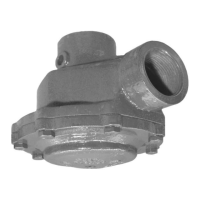Dry Pilot
Actuation
The Dry Pilot Actuation Trim provides
for installation of a detection system
consisting of pilot sprinklers (heat de-
tectors) and manual control stations
interconnected with minimum 1/2 inch
(DN15) steel pipe. The pilot line, which
is to be pressurized with air or nitro-
gen, is connected to the “Dry Pilot De-
tection” connection shown in Figures 7
and 12. Provision must be made for a
5.6 K-factor orifice, Inspector’s Test
Connection at the most remote loca-
tion from the DV-3 Valve. Nominal in-
stallation dimensions for Dry Pilot Ac-
tuation Trim are shown in Figure 7.
The Dry Pilot Actuation Trim is pro-
vided with a listed and approved Model
DP-1 Dry Pilot Actuator, which is de-
scribed in Technical Data Sheet
TFP1380.The Actuator is rated for use
at a maximum pilot service pressure of
50 psi (3,4 bar) and a maximum water
supply service pressure of 175 psi
(12,1 bar).
Operation of a pilot sprinkler or open-
ing of a manual control station re-
leases pneumatic pressure from the
pilot line. In turn, the Dry Pilot Actuator
opens resulting in a rapid pressure
drop in the Diaphragm Chamber of the
DV-3 Valve, and the force differential
holding the Center Valve Assembly
down in the set position is reduced
below the valve trip point.
Dry pilot sprinklers are to be minimum
5.6 K-factor orifice listed or approved
automatic sprinklers. Manual Control
Stations are to be the Model MC-1
described in Technical Data Sheet
TFP1382.
Graph C shows the “minimum pilot line
service pressure” as a function of the
water supply pressure. The pressure
in the dry pilot actuation system must
be automatically maintained using one
of the following maintenance devices,
as appropriate.
• Model AMD-1 Air Maintenance De-
vice (pressure reducing type), refer
to Technical Data Sheet TFP1221.
• Model AMD-2 Air Maintenance De-
vice (compressor control type), refer
to Technical Data Sheet TFP1231.
• Model AMD-3 Nitrogen Mainte-
nance Device (high pressure reduc-
ing type), refer to Technical Data
Sheet TFP1241.
NOTES
The dew point of the pilot line air pres-
sure must be maintained below the
lowest ambient temperature to which
the dry pilot actuation system will be
exposed. Accumulation of water in the
pilot line connection to the Actuator will
lower the air pressure at which the
Actuator will open and possibly pre-
vent proper operation. Also, introduc-
tion of moisture into the pilot lines ex-
posed to freezing temperatures can
create an ice buildup which could pre-
vent proper operation of the Actuator.
An air dryer must be installed where
the moisture content of the air supply
is not properly controlled at less than
the required value.
It is recommended that an AMD-3 Ni-
trogen Maintenance Device be utilized
in dry pilot actuation system applica-
tions where the dew point must be
Page8of20
TFP1350
FIGURE 5
SYSTEM SCHEMATIC — DRY PILOT ACTUATION
CONNECTION
SUPPLY
SYSTEM PIPING WITH OPEN NOZZLES OR SPRINKLERS - NORMALLY DRY
RESTRICTION
DRAIN VALVE
(NORMALLY
(MINIMUM 1/2" PIPE AND
AUTOMATIC SPRINKLERS)
DRY PILOT SPRINKLER
DETECTION SYSTEM
PRESSURE
SUPPLY
WATER
DRAIN
ALARM SWITCH
WATER SUPPLY
CONTROL VALVE
PRESSURE
OPEN)
GAUGE
(NORMALLY
MAIN
GAUGE
PRESSURE
CHAMBER
DIAPHRAGM
WATERFLOW
DRAIN
DRAIN
STATION
MANUAL
CONTROL
LOCAL
CLOSED)
MAIN
DIAPHRAGM
CHAMBER
DIAPHRAGM
(NORMALLY OPEN)
CONTROL VALVE
CHAMBER SUPPLY
VALVE
DELUGE
AUTOMATIC
DEVICE
MAINTENANCE
AIR/NITROGEN
LOW
SWITCH
ALARM
PRESSURE
DRAIN
ACTUATOR
DRY PILOT
LOCATION FROM THE
(AT THE MOST REMOTE
DELUGE VALVE
INSPECTOR'S TEST CONNECTIO
DRAIN
SPECIFIED)
STATION
CONTROL
MANUAL
REMOTE
(WHEN

